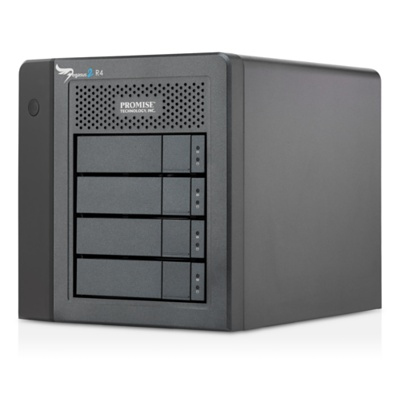
This meant my SSD RAID, which I configured in RAID 0, wouldn’t be impacted by the HDDs which are significantly slower. One was called SSD RAID and one was called HDD RAID.

Obviously for maximum performance I wouldn’t want to have the HDDs in a RAID with the SSDs, so using the app I created two different arrays. For example, I was sent an R6 with four SSDs and two HDDs. The nice thing about the Pegasus3 Utility is that it will allow you to split up the drives into more than one array. You should then see a dashboard page within the app that looks similar to the one in the screenshot below.įrom there you will want to create a disk array. Once both of those are installed, plug in the Pegasus3 into your computer via one of the two Thunderbolt 3 ports on the back of the device and open up the Utility app.
#PROMISE PEGASUS R4 REPLACE ALL DRIVES INSTALL#
After the drivers are installed you will need to download and install the Pegasus3 Utility (which can also be found on their site)–this will allow you to setup and configure the drives for use on your computer. The first thing you’ll have to do is install the Pegasus3 drivers on your computer (which can be found on Promise’s site). We’ll touch on that in a bit, but first, I want to discuss setting up the Pegasus3 R6 with my Mac. It’s worth noting that according to Promise typical HDD performance will be approximately 200MB/s reads and 200MB/s writes, per drive and typical SSD performance will be approximately 500MB/s reads and 500MB/s writes, per drive. The R6 model that Promise sent to us included 4 2TB SSD’s and 2 10TB HDD’s. Pegasus3 R6 connected via Thunderbolt 3 to a MacBook Pro.

Once we got the Pegasus3 R6 unboxed, we started testing it. Additionally, it’s not currently possible to buy a Pegasus3 R6 and only buy four drives–the company currently requires you fill all the drive bays when purchasing any of the models, which is a bit annoying (at least to me). On the SSD side of things, the choices a bit more limited with the only options being 1TB or 2TB SSDs. Promise offers a wide range of options when it comes to traditional hard drives, you can select anywhere from 3TB to 10TB drives. For example, if you went with the R6 model you would have the option to choose the number of traditional hard drives you want (if any) and the amount of solid state drives you would want (if any).

The BTO Pegasus3, which can be configured on Promise’s website, allows customers to choose what kind of drives as well as the amount of storage they’re looking for. It used to be that Promise had pre-configured models that they sold on their site, and while they still do offer pre-configured models, the company now also offers the ability for you to configure a built to order (BTO) model. The R4 comes with 4 drive bays, the R6 with 6, and you guessed it, the R6 with 8 drive bays.
#PROMISE PEGASUS R4 REPLACE ALL DRIVES SERIES#
Promise recently updated their Pegasus series of products to support Thunderbolt 3, like the Pegasus2 line before it, the updated Pegasus3 product line comes in three models: the R4, R6, and R8.


 0 kommentar(er)
0 kommentar(er)
